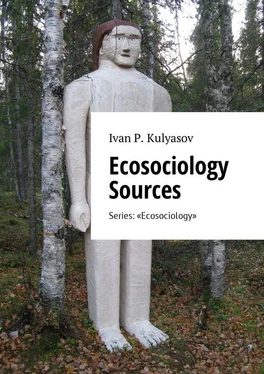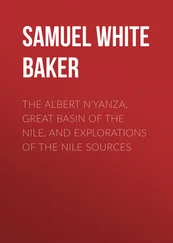I. Kulyasov - Ecosociology Sources. Series - «Ecosociology»
Здесь есть возможность читать онлайн «I. Kulyasov - Ecosociology Sources. Series - «Ecosociology»» — ознакомительный отрывок электронной книги совершенно бесплатно, а после прочтения отрывка купить полную версию. В некоторых случаях можно слушать аудио, скачать через торрент в формате fb2 и присутствует краткое содержание. ISBN: , Жанр: Прочая научная литература, на английском языке. Описание произведения, (предисловие) а так же отзывы посетителей доступны на портале библиотеки ЛибКат.
- Название:Ecosociology Sources. Series: «Ecosociology»
- Автор:
- Жанр:
- Год:неизвестен
- ISBN:9785449009913
- Рейтинг книги:5 / 5. Голосов: 1
-
Избранное:Добавить в избранное
- Отзывы:
-
Ваша оценка:
- 100
- 1
- 2
- 3
- 4
- 5
Ecosociology Sources. Series: «Ecosociology»: краткое содержание, описание и аннотация
Предлагаем к чтению аннотацию, описание, краткое содержание или предисловие (зависит от того, что написал сам автор книги «Ecosociology Sources. Series: «Ecosociology»»). Если вы не нашли необходимую информацию о книге — напишите в комментариях, мы постараемся отыскать её.
Ecosociology Sources. Series: «Ecosociology» — читать онлайн ознакомительный отрывок
Ниже представлен текст книги, разбитый по страницам. Система сохранения места последней прочитанной страницы, позволяет с удобством читать онлайн бесплатно книгу «Ecosociology Sources. Series: «Ecosociology»», без необходимости каждый раз заново искать на чём Вы остановились. Поставьте закладку, и сможете в любой момент перейти на страницу, на которой закончили чтение.
Интервал:
Закладка:
Statistical efforts made by the government since 1764 included the general inventory of MaloRossia, general land surveying and topographic descriptions of provinces, which comprised descriptions containing cultural-historical, geographical, administrative and economic characteristics. These new methodologies for gathering, processing and analysis of diverse data using a single question structure were important for development of sciences in general and for ecosociology. The emergence of economic statistics in the 18 thcentury and its further development provides retrospective research material for analyzing social dynamics and interaction with natural resources.
Aleksandr Nikolaevich Radishchev (1749—1802) was instrumental in further development of Russian statistics, using both the Academy of Sciences and his own data obtained in the course of, one can say, an ecosociological research in his estate 59 59 Radishchev A.N. Letter about Chinese bargaining. St. Petersburg. 1794.; The description of my possession… St. Petersburg. 1799. (all in Russian)
. This data was later used for substantiating expert proposals.
In his work “ On legal provisions ”, he writes that the government is complaining that the huge Russian territories are scantily populated. With 12—20 children born to a typical peasant family, less than a quarter reach adult age. The government does not know the causes of child mortality and the cause probably lies in the arduous economic conditions of peasant’s life. Many landlords reside outside their land holdings and, totally unaware of the working conditions of their peasants, levy a rent of 1—2 rubles, and some – even 5 rubles. However, this rent should be levied based, as a minimum, on soil fertility. He proposed to exempt the peasants living in areas characterized by infertile soil, harsh climatic conditions and the absence of abundant hunting acreage from the state duty and rent to the landlord.
Further, he suggests establishing a nationwide system of taxes on production and trade based on such poll data from provincial censuses as the number and quality of population (composition and standard of living), land (fertility and capability), local industries (plants and factories) and crafts (product types and output, number of workers, including seasonal ones). The next category of questions relates to various types of duties, landowners, recruitment, road maintenance, prisoners, issue of money and police maintenance costs 60 60 Radishchev A.N. On the Statute. St. Petersburg. 1802. (in Russian)
.
In the end of the 18 thcentury, Lyudvig Wolfgang Krafft (1743—1814) formulated the need and suggested a statistical methodology for population accounting using mortality and birth rates, deriving a formula for calculating the population doubling time 61 61 Krafft W.L. Lists marriages, births and deaths in Sent Petersburg over 1791—1796. St. Petersburg: Imperial Academy of Sciences. 1801. Vol. 12. (in Russian)
. In doing this, he strengthened the statistical approach to sociology as a method used in exact sciences, giving momentum to development of quantitative methods in international sociology.
Russia’s first statistical branch, affiliated to the Police Ministry, was then established on 20 March 1811.
Karl Feodorovich German (1767—1838), the first director of this statistical office, specialized in the subject as a researcher and lectured in the state educational institutions 62 62 German K.F. Statistical description of the Yaroslavl province. St. Petersburg. 1808.; A short guide to General history statistics. St. Petersburg. 1808.; General theory of statistics. St. Petersburg. 1809.; Historical review of literature of statistics, in particular the Russian state. St. Petersburg. 1817.; Statistical research on the Russian Empire. Part I: Population. St. Petersburg. 1819. (all in Russian)
. Other ministries also conducted statistical surveys and published their results. However, they were more interested in departmental data, frequently – about their numerous officials, official buildings and bureaucratic routine conducted in towns and provinces.
After a series of state-initiated reforms and internal reorganization of statistical institutions, the Russian Empire’s first general census of the population was taken in 1897. The results were published in 1899 in 89 volumes featuring data by province. Subsequent editions, containing analytical statistical materials in figures and diagrams, were then published regularly until the year 1905 63 63 Troynitsky N. (ed.) The first general census of the Russian Empire in 1897. St. Petersburg: Central Statistical Committee of the Ministry of Internal Affairs. 1897—1905. (in Russian)
.
The county councils (or “ zemstvo ” – Russian sound), established by the 1864 reform, conducted their own local social and statistical surveys studying the social structure of the population, social categories, economic activity of peasants and factory workers, their living conditions, education and sanitary culture. In the beginning of the 20 thcentury, a systematic research of this kind covered 17 provinces of the Russian Empire.
This statistical activity has provided and continues to provide ample material for retrospective sociological analysis and theorizing. The professionalism of researchers and census takers, statistical techniques and methods for data processing have been improving all the time, including the Soviet period. And, as some statistical points dealt with interaction between humans and the natural environment, this material and research approach remain relevant for ecosociologists until today.
In the Soviet period, beginning with the 1920s, Russian science was dominated by the Marxist-Leninist ideology; therefore, all ecological ideas, theories and concepts proposed by foreign colleagues were criticized for a “bourgeois” approach. The state funded and strictly controlled scientific research, especially works of authorship. The same control was exercised over ideas inspiring public initiatives, with the only objective being construction of a socialist and, afterwards, a communist society. Everyone was supposed to comply with the resolutions issued by the communist party congresses that were aimed at industrialization, economic growth and extensive use of natural resources.
At the same time, love for nature and proper ecological behavior (ecologism) were taught at schools and propagandized by books for children and young people. For example, school curriculums included such subjects as nature study and studies of local history, books about nature written by Russian and Soviet writers. These provided basic knowledge about environmental links and systems, proper attitude and interaction with natural sites, methods of their conservation, beneficial use and restoration.
This field of Russian teacher’s activity, lasting for two centuries of the pre-Soviet period, seven decades of the Soviet era and until today, is largely overlooked and little known by Russian ecosociologists. In the post-Soviet period, it has taken the form of continuous ecological education and mass ecological movement supported by a huge number of peaceful, positive-minded high school- and college-based ecological groups uniting many lecturers (both in natural and social sciences), students and their parents 64 64 Korobeynikova L.A. (ed.) Environmental education and education of youth: the experience of schools, extracurricular institutions and universities. Vologda: Vologda State Pedagogical University: Rus’. 1993.; Continuous environmental education: problems, experience, prospects // Proceedings of the II Interregional scientific and practical conference. Tomsk. November 6—7, 2008. (all in Russian)
.
Интервал:
Закладка:
Похожие книги на «Ecosociology Sources. Series: «Ecosociology»»
Представляем Вашему вниманию похожие книги на «Ecosociology Sources. Series: «Ecosociology»» списком для выбора. Мы отобрали схожую по названию и смыслу литературу в надежде предоставить читателям больше вариантов отыскать новые, интересные, ещё непрочитанные произведения.
Обсуждение, отзывы о книге «Ecosociology Sources. Series: «Ecosociology»» и просто собственные мнения читателей. Оставьте ваши комментарии, напишите, что Вы думаете о произведении, его смысле или главных героях. Укажите что конкретно понравилось, а что нет, и почему Вы так считаете.




![Джеймс Купер - Пионеры, или У истоков Саскуиханны [The Pioneers, or The sources of the Susquehannah]](/books/395797/dzhejms-kuper-pionery-ili-u-istokov-saskuihanny-t-thumb.webp)







